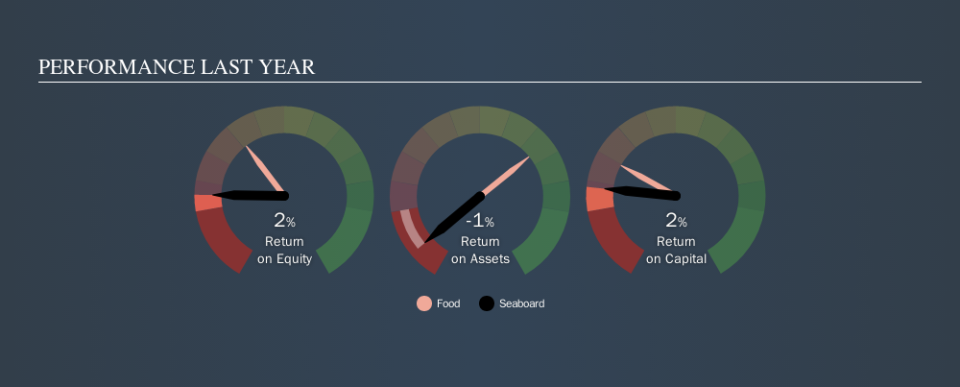Should Seaboard Corporation’s (NYSEMKT:SEB) Weak Investment Returns Worry You?

Today we are going to look at Seaboard Corporation (NYSEMKT:SEB) to see whether it might be an attractive investment prospect. Specifically, we're going to calculate its Return On Capital Employed (ROCE), in the hopes of getting some insight into the business.
First of all, we'll work out how to calculate ROCE. Next, we'll compare it to others in its industry. Finally, we'll look at how its current liabilities affect its ROCE.
What is Return On Capital Employed (ROCE)?
ROCE measures the amount of pre-tax profits a company can generate from the capital employed in its business. All else being equal, a better business will have a higher ROCE. In brief, it is a useful tool, but it is not without drawbacks. Renowned investment researcher Michael Mauboussin has suggested that a high ROCE can indicate that 'one dollar invested in the company generates value of more than one dollar'.
So, How Do We Calculate ROCE?
Analysts use this formula to calculate return on capital employed:
Return on Capital Employed = Earnings Before Interest and Tax (EBIT) ÷ (Total Assets - Current Liabilities)
Or for Seaboard:
0.019 = US$95m ÷ (US$5.9b - US$905m) (Based on the trailing twelve months to June 2019.)
So, Seaboard has an ROCE of 1.9%.
See our latest analysis for Seaboard
Does Seaboard Have A Good ROCE?
ROCE is commonly used for comparing the performance of similar businesses. We can see Seaboard's ROCE is meaningfully below the Food industry average of 8.2%. This performance could be negative if sustained, as it suggests the business may underperform its industry. Independently of how Seaboard compares to its industry, its ROCE in absolute terms is low; especially compared to the ~2.7% available in government bonds. It is likely that there are more attractive prospects out there.
Seaboard's current ROCE of 1.9% is lower than 3 years ago, when the company reported a 4.7% ROCE. This makes us wonder if the business is facing new challenges. You can click on the image below to see (in greater detail) how Seaboard's past growth compares to other companies.
When considering ROCE, bear in mind that it reflects the past and does not necessarily predict the future. Companies in cyclical industries can be difficult to understand using ROCE, as returns typically look high during boom times, and low during busts. ROCE is only a point-in-time measure. You can check if Seaboard has cyclical profits by looking at this free graph of past earnings, revenue and cash flow.
How Seaboard's Current Liabilities Impact Its ROCE
Current liabilities are short term bills and invoices that need to be paid in 12 months or less. Due to the way ROCE is calculated, a high level of current liabilities makes a company look as though it has less capital employed, and thus can (sometimes unfairly) boost the ROCE. To check the impact of this, we calculate if a company has high current liabilities relative to its total assets.
Seaboard has total assets of US$5.9b and current liabilities of US$905m. As a result, its current liabilities are equal to approximately 15% of its total assets. This is not a high level of current liabilities, which would not boost the ROCE by much.
The Bottom Line On Seaboard's ROCE
While that is good to see, Seaboard has a low ROCE and does not look attractive in this analysis. But note: make sure you look for a great company, not just the first idea you come across. So take a peek at this free list of interesting companies with strong recent earnings growth (and a P/E ratio below 20).
I will like Seaboard better if I see some big insider buys. While we wait, check out this free list of growing companies with considerable, recent, insider buying.
We aim to bring you long-term focused research analysis driven by fundamental data. Note that our analysis may not factor in the latest price-sensitive company announcements or qualitative material.
If you spot an error that warrants correction, please contact the editor at editorial-team@simplywallst.com. This article by Simply Wall St is general in nature. It does not constitute a recommendation to buy or sell any stock, and does not take account of your objectives, or your financial situation. Simply Wall St has no position in the stocks mentioned. Thank you for reading.

